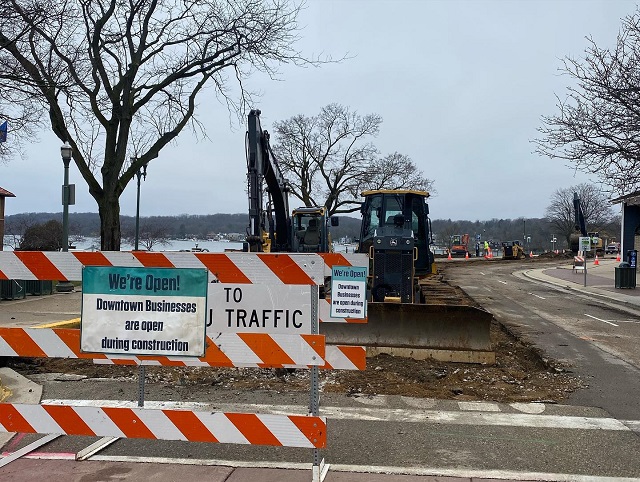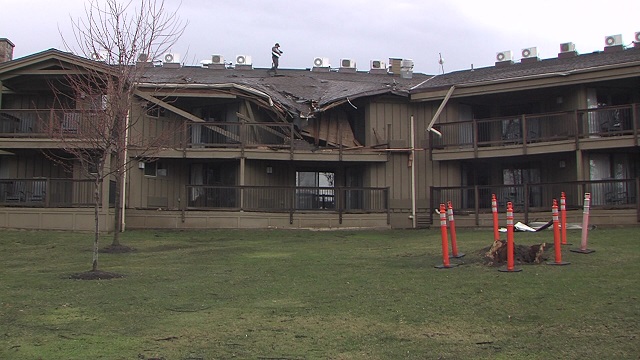LIVING HERE
The recent storm took down part of Lake Lawn Resort in Delavan.
A tornado touched down in Sharon, Wisconsin on Friday night. It traveled in a northeastern direction, headed almost straight for Lake Geneva. At the very end of its eleven mile run across the ground it pulled back up into the clouds, but not before taking out some of the huge trees surrounding the Lake Lawn Resort, located just south of Highway 50 east of the main city of Delavan by some small margin. The first tornados of 2023 were confirmed in southern Wisconsin. Severe storms produced at least 3 tornadoes in southern Wisconsin on Friday night with a dynamic early spring storm system. The National Weather Service (NWS) in Milwaukee has so far confirmed at least three tornadoes that impacted Rock and Walworth Counties on Friday night, March 31 from approximately 7:45 p.m. to 8:10 p.m. Unstable weather conditions were found in southern and southeast Wisconsin Friday night, as a cold front and low pressure tracked through the region. Severe storms produced damaging winds, hail, and at least a few tornadoes. All the tornadoes were EF-O, with max winds of around 80 mph.
The Fujita scale is used to denote the strength of tornado winds, the scale going all the way up to EF-5 which would be winds of over 200MPH. Two EF-O tornadoes were confirmed in Walworth County – one moving from Sharon to Delavan Lake and the other one traveling on the ground from Como to Elkhorn. A third, also an EF-O scale tornado, was confirmed to have come down from the clouds in Beloit. NWS crews were out Saturday to view what was left behind; “to see how far the damage path goes and how intense it was.”
On April Fool’s Day, the damage was not a joke to anyone in the area, with roofs being torn off buildings, trees being uprooted, and debris scattered for miles. NWS representatives stated, as the area is just entering severe weather season, that it is important to be prepared and have severe weather notifications set up and a plan in place (where to take shelter and what to have prepared to take shelter with…like water, battery-powered lights, and pet carriers).
Yerkes has survived the many doubts about its future.
The last five years have been a rocky road for the observatory, located in Williams Bay, which had an unknown future for quite some time. The observatory was no longer affiliated with the University of Chicago who was having difficulties funding the upkeep of the observatory and its grounds. As promised, the university found a buyer to keep Yerkes’ mission alive and to bring it back to its former glory. The Yerkes Future Foundation, a nonprofit made up of concerned citizens, took over the observatory from the University almost one year ago. This historical landmark means a lot to not just locals but visitors as well because there is a lot of significance to the observatory. Yerkes is the birthplace of modern astrophysics and the largest refracting telescope in the world with renowned visitors such as Albert Einstein. George Ellery Hale, one of the pioneers of astrophysics, was the leader in the planning and constructing of the 40-inch refracting telescope there. Completed in 1897, the observatory has amazing sculptures and details, with interesting stories behind many of the sculptures and faces throughout the building.
The observatory and grounds truly are a destination and gem right here in our own backyard. One of the great new features of the observatory is the behind-the-scenes tour. The great thing about this tour is that you can access areas that are not included in a regular tour. As such, you can climb up into the domes and make your way back through storage areas filled with yet undiscovered treasures. The observatory also holds a collection of over 170,000 photographic plates. The amount of history stored in this observatory is mind-blowing. In preparation for the coming summer season an increase in tours Yerkes recently announced plans to add more staff: two full-time and three part-time positions have been posted. Whether the Observatory, or the outfit fronting for it, is really able to raise enough money to pay for a complete rebuild of the structure, the main dome, giant elevator that raises and lowers to accommodate the main telescope, and the repair of that main telescope (the world’s largest refracting telescope), is subject to a whole lot of conjecture, at this point, however.
The major construction project on Wrigley Drive is underway.
The drive has been a subject of fairly contentious debate over the past few years, with many interested parties and developers putting forth the idea that Wrigley Drive should be closed to all traffic and the street converted into a park-like area with pedestrian walks and plenty of benches to sit and take in the wonderful scenery provided by the northern edge of Geneva Lake. The redevelopment of Wrigley drive going on as this is written, sort of puts a stake in such ideas. The road is being totally taken out and rebuilt. The curbs are being replaced with new ones. The sidewalks are also being reworked, with the old concrete being torn up and new concrete set in. The work is going extremely fast, with the street department having torn up most of the old broken and cracked asphalt during only the first day of the project. When the Department of Public Works of Lake Geneva indicated that the project would be expedited, it wasn’t kidding. Go down to the lake and watch the monster machines at work, as that sight alone is worth the visit.
Wrigley Drive







